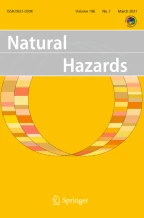3368Accesses
61Citations
20 Altmetric
2Mentions
Abstract
Arctic sea ice has declined rapidly over the past four decades at the rate of − 4.7% per decade leading to an imbalance in the oceanic heat flux. The study reported that the July 2019 was the warmest month in the Arctic, leading to a substantial sea ice loss in the last 41 years. Consequently, during this month, the lowest sea ice extent (SIE, 7.5 million km2) and sea ice volume (8900 km3) were recorded. The decadal trend of sea ice decline in September 2019 has reached to ca. − 13% per decade. The latest record shows that average SIE during summer 2019 (5.65 million km2) has set a new lowest record after 2012 (5.32 million km2), since the sea ice formation process has been largely hampered during the summer months. The study reveals that the land–ocean warming processes intensifying the sea ice loss and also leading in disruption of the global ocean circulation.
This is a preview of subscription content,log in via an institution to check access.
Access this article
Subscribe and save
- Starting from 10 chapters or articles per month
- Access and download chapters and articles from more than 300k books and 2,500 journals
- Cancel anytime
Buy Now
Price includes VAT (Japan)
Instant access to the full article PDF.


Explore related subjects
Discover the latest articles, books and news in related subjects, suggested using machine learning.References
Boé J, Hall A, Qu X (2009) September sea-ice cover in the Arctic Ocean projected to vanish by 2100. Nat Geosci 2:341–343.https://doi.org/10.1038/ngeo467
Castruccio FS, Ruprich-Robert Y, Yeager SG et al (2019) Modulation of Arctic Sea ice loss by atmospheric teleconnections from Atlantic multidecadal variability. J Clim 32:1419–1441.https://doi.org/10.1175/JCLI-D-18-0307.1
Gascard J-C, Zhang J, Rafizadeh M (2019) Rapid decline of Arctic sea ice volume: causes and consequences. Cryosph Discuss.https://doi.org/10.5194/tc-2019-2
Huang Y, Dong X, Bailey DA et al (2019) Thicker clouds and accelerated Arctic sea ice decline: the atmosphere-sea ice interactions in spring. Geophys Res Lett.https://doi.org/10.1029/2019GL082791
Kwok R, Cunningham GF, Wensnahan M et al (2009) Thinning and volume loss of the Arctic Ocean sea ice cover: 2003–2008. J Geophys Res.https://doi.org/10.1029/2009JC005312
NSIDC (2019) Arctic sea ice reaches second lowest minimum in satellite record. In: Arct. Sea Ice News Anal.https://nsidc.org/arcticseaicenews/2019/09/arctic-sea-ice-reaches-second-lowest-minimum-in-satellite-record/. Accessed 3 Oct 2019
Parkinson CL, Comiso JC (2013) On the 2012 record low Arctic sea ice cover: combined impact of preconditioning and an August storm. Geophys Res Lett 40:1356–1361.https://doi.org/10.1002/grl.50349
Polyakov IV, Pnyushkov AV, Timokhov LA et al (2000s) Warming of the intermediate Atlantic water of the Arctic Ocean in the 2000s. J Clim 25:8362–8370.https://doi.org/10.1175/JCLI-D-12-00266.1
Smith DM, Dunstone NJ, Scaife AA et al (2017) Atmospheric response to Arctic and Antarctic sea ice: the importance of ocean–atmosphere coupling and the background state. J Clim 30:4547–4565.https://doi.org/10.1175/JCLI-D-16-0564.1
Wu Z, Wang X (2018) Variability of Arctic sea ice (1979–2016). Water 11:23.https://doi.org/10.3390/w11010023
Zhang J, Lindsay R, Schweiger A, Steele M (2013) The impact of an intense summer cyclone on 2012 Arctic sea ice retreat. Geophys Res Lett 40:720–726.https://doi.org/10.1002/grl.50190
Acknowledgements
We gratefully acknowledge Dr. M. Ravichandran, Director, National Centre for Polar and Ocean Research (NCPOR) and Ministry of Earth Sciences, for the continuous support and encouragement. Juhi Yadav thanks the University Grants Commission (UGC), New Delhi, India, for the award of Junior Research Fellowship [No. F.15-6(DEC.2018)/2019(NET)]. We greatly acknowledge various organizations such as National Snow and Ice Data Center (NSIDC), National Oceanic and Atmospheric Administration (NOAA), National Centre for Atmospheric Research (NCAR) and thePolar Science Center, Applied Physics Laboratory for making various datasets available in their portals. Authors thank Prof. Thomas Glade, Editor-in-Chief for his insightful comments and suggestions. This is NCPOR contribution no J-5/2020-21.
Author information
Authors and Affiliations
National Centre for Polar and Ocean Research, Ministry of Earth Science (Govt. of India), Vasco-da-Gama, Goa, India
Juhi Yadav, Avinash Kumar & Rahul Mohan
- Juhi Yadav
Search author on:PubMed Google Scholar
- Avinash Kumar
Search author on:PubMed Google Scholar
- Rahul Mohan
Search author on:PubMed Google Scholar
Corresponding author
Correspondence toAvinash Kumar.
Additional information
Publisher's Note
Springer Nature remains neutral with regard to jurisdictional claims in published maps and institutional affiliations.
Rights and permissions
About this article
Cite this article
Yadav, J., Kumar, A. & Mohan, R. Dramatic decline of Arctic sea ice linked to global warming.Nat Hazards103, 2617–2621 (2020). https://doi.org/10.1007/s11069-020-04064-y
Received:
Accepted:
Published:
Issue date:
Share this article
Anyone you share the following link with will be able to read this content:
Sorry, a shareable link is not currently available for this article.
Provided by the Springer Nature SharedIt content-sharing initiative
